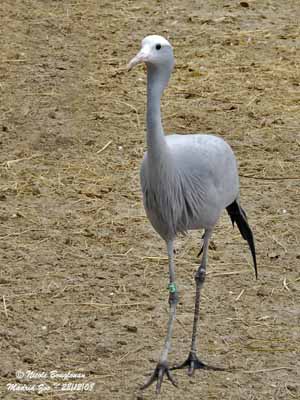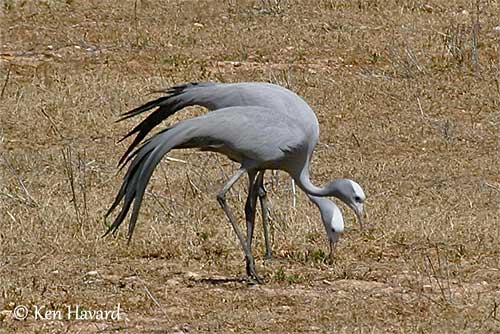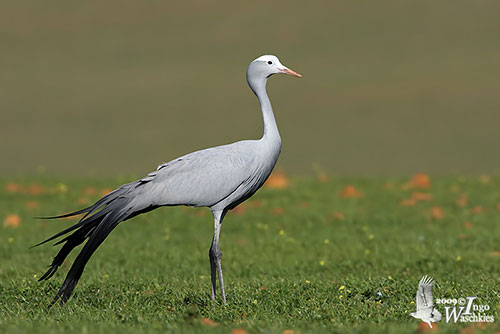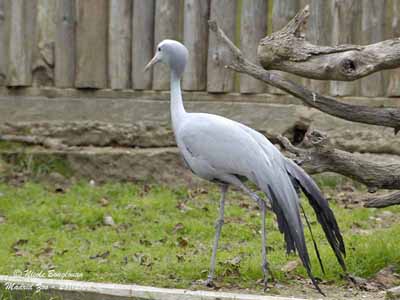
Fr: Grue de paradis
All : Paradieskranich
Esp : Grulla del Paraíso
Ital: Gru del Paradiso
Nd: Stanley-kraanvogel
Sd: Paradistrana
Photographers:
Ken Havard
My Bird Gallery & Flickr gallery 1 & Flickr gallery 2
Ingo Waschkies
My bird pictures on Pbase
Callie de Wet
GALLERY
Nicole Bouglouan
PHOTOGRAPHIC RAMBLE
Text by Nicole Bouglouan
Sources:
HANDBOOK OF THE BIRDS OF THE WORLD Volume 3 by Josep del Hoyo-Andrew Elliott-Jordi Sargatal - Lynx Edicions - ISBN : 8487334202
BIRDS OF AFRICA SOUTH OF THE SAHARA by Ian Sinclair and Peter Ryan - Princeton University Press Princeton and Oxford - ISBN: 0691118159
BirdLife International (BirdLife International)
International Crane Foundation
Wikipedia, the free encycolpedia
Blue Crane
Grus paradisea
Gruiforme Order – Gruidae Family
BIOMETRICS:
Length: 110-120 cm
Wingspan: 180-200 cm
Weight: 4900-5300 g
DESCRIPTION:
The Blue Crane is the South African’s national bird.
This species has entirely feathered head, and lacks the bright coloured patches of bare skin.
The head, neck and body are uniform bluish-grey. On the wings, the primary flight feathers are black or dark grey. The tertials are fairly elongated with black tips. They dangle almost to the ground, giving the bird an elegant appearance. The breast feathers are longer around the neck base.

On the head, crown and forehead are pale greyish-white. Cheeks, ear-coverts and nape are darker grey.
During the displays, the crane fluffs the loose feathers of cheeks and upper nape, involving a strange cobra-like head.
Comparing with most of other cranes’ species, the Blue Crane has relatively short pink bill. The eyes are dark brown. Long legs and feet are dark grey to blackish.

Both sexes have similar plumage but the male is larger than the female.
The juvenile is pale grey, and lacks the elongated tertial feathers.
The chick has dark grey body and brown head. Legs and feet are black.
VOICE: SOUNDS BY XENO-CANTO
The Blue Crane gives loud, nasal “kraaaank” and low-pitched, raspy sounds. We can also hear rattling far-carrying croak.
HABITAT:
The Blue Crane frequents mainly the dry uplands with grasses and sedges, and the wetlands for roosting and nesting.
But this crane is also found in modified habitats such as cultivated areas, pastures and fallow fields.
RANGE:
The Blue Crane lives in restricted range in E and S of South Africa. Another small isolated population occurs in Etosha Pan, N Namibia.
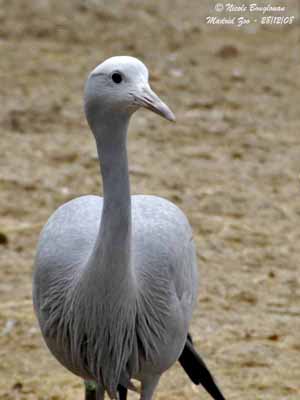
BEHAVIOUR:
The Blue Crane is more terrestrial than other large cranes. Its shorter toes allow this bird to run better and faster. The shorter bill is also an adaptation to the feeding behaviour, because this crane feeds more often in grasslands than in wetlands.
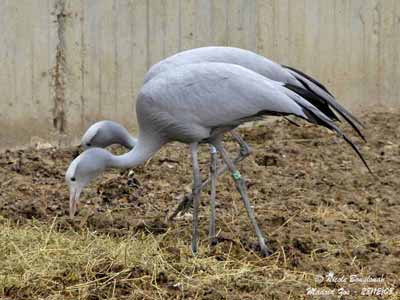
The cranes forage by walking, searching on the ground and pecking at the surface and vegetation. It occasionally digs for food, but less often than other cranes due to the shorter bill.
They usually forage in pairs or in small family groups.
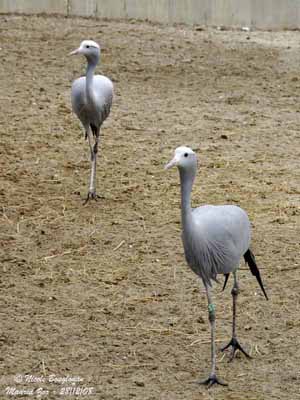
During the breeding season, as other Gruidae species, the Blue Crane performs beautiful displays. Both mates give unison calls, series of coordinated raspy sounds. During the dances, the birds throw the head back with the bill upwards. The male raises its wings whereas the female keeps them closed.
All cranes engage in dancing, with bowing, jumping, running, they toss some stick or plant item into the air and flap their wings.
This behaviour is associated with courtship, but it is also used as social behaviour, calming the aggressivity and strengthening the pair-bonds.
The Blue Crane is non-migratory. They perform local and seasonal movements within the range, and are vagrant in Botswana, Lesotho, Swaziland and Zimbabwe.
FLIGHT:
The Blue Crane has powerful flight after running to take off. It performs steady, strong wing beats, and alights with dangling legs before to reach the ground.
REPRODUCTION:
The breeding season occurs in October-December, during the summer.
The Blue Crane nests mainly in grasslands at high elevation, but also in pastures, cultivated areas, marshes or grasslands near water.
The nest is a platform made with aquatic vegetation, often reeds and small stones. That is always a very simple structure.
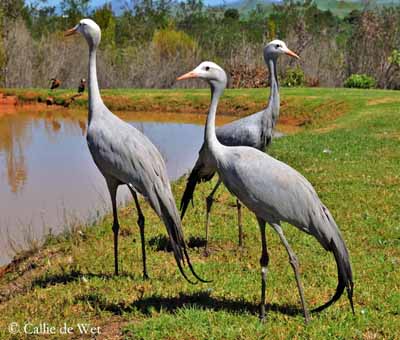
The female lays 2 eggs. The incubation lasts about 30-33 days, shared by both parents. The young follow the adults very soon after hatching to forage with them.
They fledge between 3 and 5 months, and are sexually mature at 3-5 years.
DIET:
The Blue Crane feeds on plant matter such as seeds from grasses and sedges, roots, tubers, waste cereal grain such as maize and wheat.
But their diet also includes large insects, mainly locusts and grasshoppers, and also worms, fish, frogs, crabs, reptiles and small rodents.
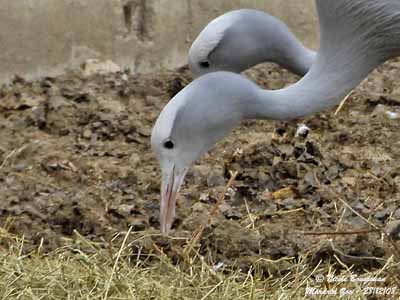
PROTECTION / THREATS / STATUS:
The Blue Crane is still considered as crop pest in some parts of the range, and suffers direct or indirect poisoning for this reason.
They are threatened by human developments, habitat loss, drainage of wetlands, agricultural expansion, persecution, overgrazing, predation by dogs and illegal pet-trade.
This species is evaluated as VULNERABLE. Several programs are in progress in order to protect the habitat and this bird.
